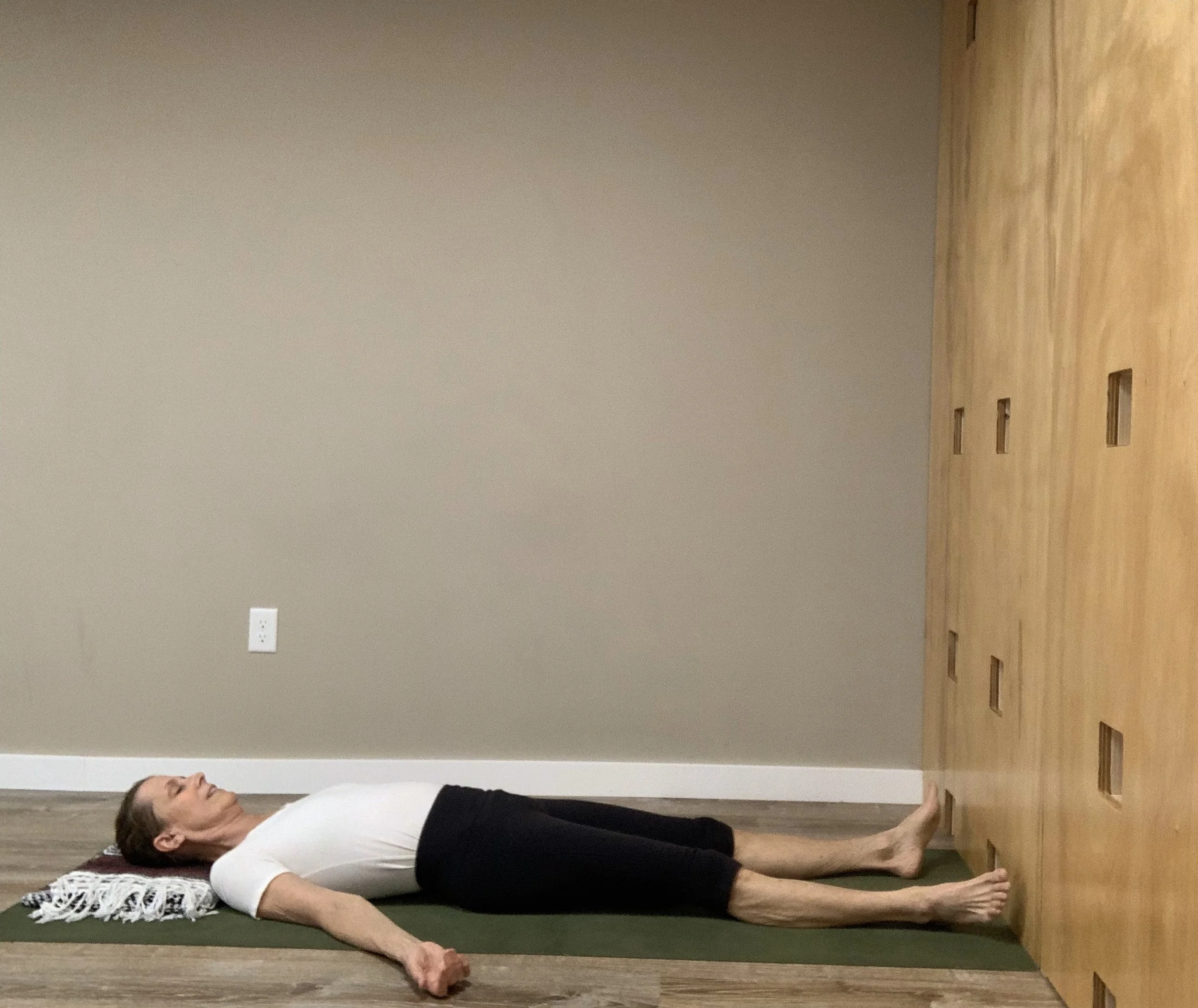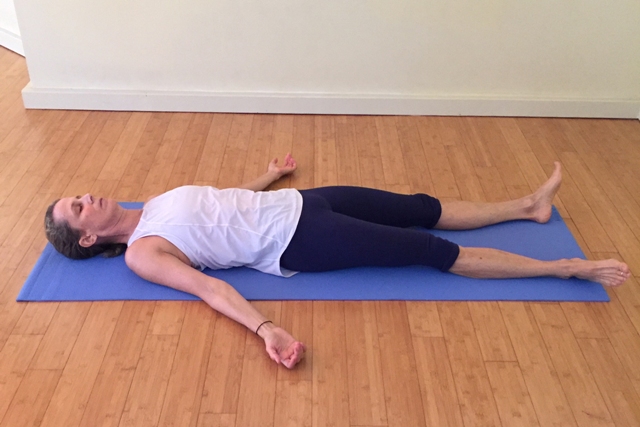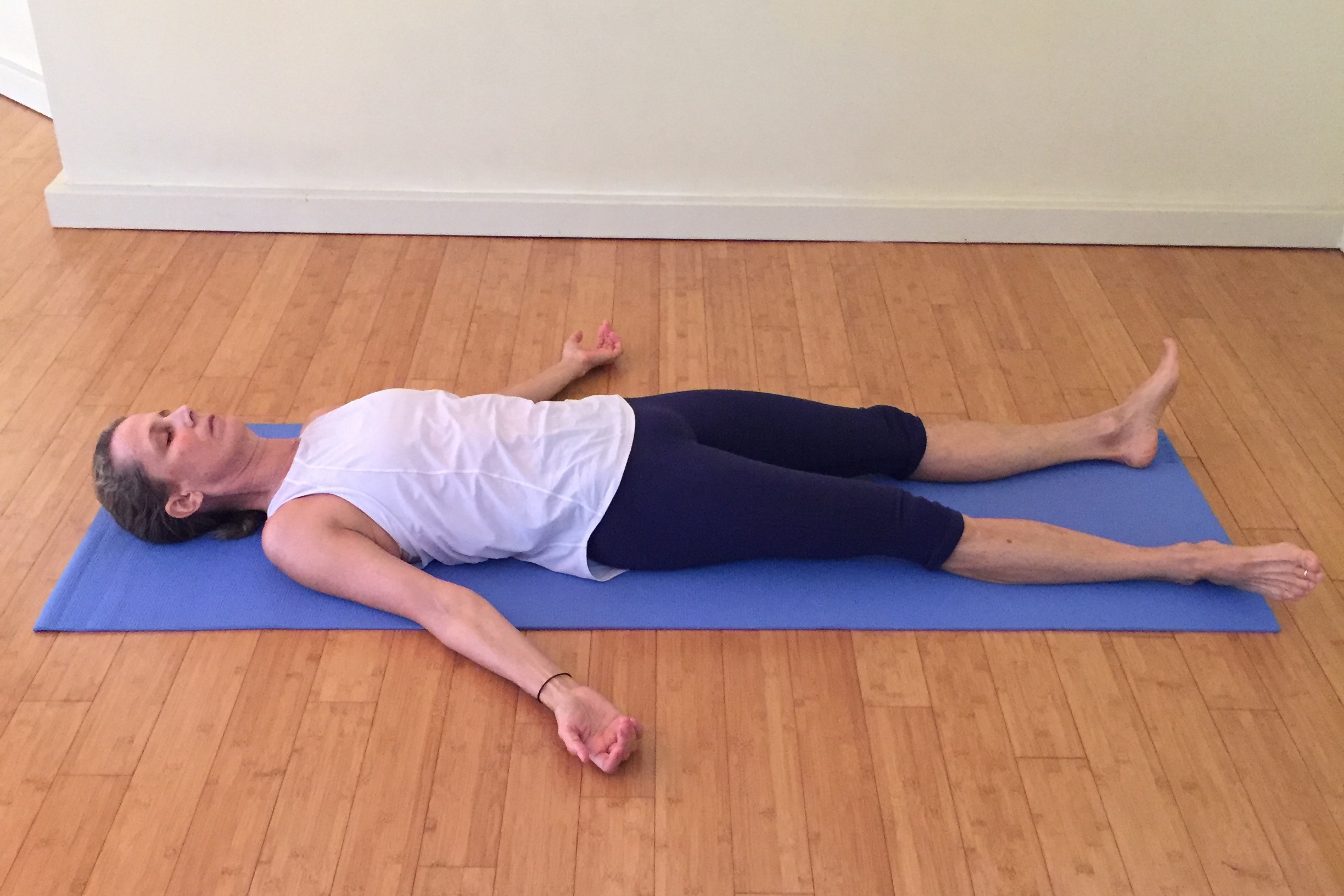Just like other asanas, even in Savasana you progress through various stages and levels until the asana is mastered.
How to come out of Savasana
Who would have thought that you need instructions to come out of Savasana?! Don’t you just get up off the floor? Do I really need to be told how to do that?
Yoga is a practice of intention, of being aware of what you are doing and how you are doing it, not just while you are in the pose, but before you come into it and after you come out of it. How you come into the pose affects how you are in the pose and how you come out of the pose defines how much of the pose you take with you.
Your asana practice challenges you physically; to stretch and to be strong, and mentally to be present and to be discriminating. Most students tell me that they feel calmer after their yoga practice. That is because the practice works not just on our bodies, but our minds as well. We enter a calmer mental state. Another way to put that is to say that your asana practice can take you out of a mental state of high alert, also known as fight or flight, and put you into a calmer and more relaxed state, also known as rest and digest.
How you come out of Savasana after your yoga practice can either keep you in that calmer state, or jolt you right back into fight or flight. Let’s take a look at what can happen.
Hopefully, you have been able to drop into a deep state of relaxation in Savasana. Your body is still, your mind is quiet and your breathing has slowed down and become very soft and subtle.
The first instruction for coming back from Savasana is to begin to increase your breath. The breath is prana, or energy and as such, it begins to energize the body. I usually guide my students to breathe into their arms and legs and up into their neck and head. When you feel the energy of the breath in these areas of the body you can begin to move and stretch by starting with small movements in the fingers and toes, moving up to the wrists and ankles. At this point you can begin to bend your knees and elbows and turn your chin from side to side.
When you are ready you can roll to your side and pause for a moment, drawing your knees up into your chest in a fetal position and cradling your head on your arm. When you are ready to sit up, roll towards the floor and use your hands to push yourself up, allowing the head to come up last.
If you come up in this manner, you will still be in that sense of calmness and quietude cultivated through the combination of your practice and Savasana. This will help preserve the sense of rest and digest that is equated with a more relaxed mental state.
However, some students may not be able to relax and drop into a restful state in Savasana.
Sometimes students lie still through the instructions for coming back from Savasana and instead of coming up gradually, they sit bolt upright by doing a quick abdominal crunch. Have these students been able to relax? Maybe these students obediently lie back during Savasana but instead of relaxing they are waiting to be “released” from the pose.
Coming up from Savasana in this manner quickly jolts your system out of rest and digest into the state of fight or flight. This is done by a combination of quickly contracting the abdominal muscles and hip flexors which send a message of danger to the brain. This is an action most animals take to protect their visceral organs from being attacked. And although we are not being attacked the reflex action sends off a cascade of nerve signals which triggers the brain into a highly alert state. While most of us will eventually get back to this state on our own, there is no need to rush the process.
So, the next time you are in savasana, try to relax. If you can’t relax, at least lie still and breathe as slowly, deeply and as evenly as you can without creating any stress. And when you come out, do so gradually and notice how you feel.
Yoga means to yoke the body, mind and the spirit. Allow your yoga practice to work on more than just your body by paying attention to how you come out of Savasana.
Learning to Relax.
The pose of the month for December is Savasana. That does not mean that we will spend the entire class in Savasana. Just like every other pose of the month, we will spend maybe 10 or 15 minutes working on the featured pose. (And, if you are lucky, you will get a lovely Savasana assist by yours truly!)
So what do we need to work on in Savasana? Aren’t we just supposed to relax and do nothing? Absolutely, but how many of us can do so? I know many students who cannot stay for Savasana. They don’t see the value in “doing nothing”.
But relaxation is so important, it breaks the stress cycle. We all know how stress is bad for our body and immune system. (You can read about how harmful stress is for your body here.) While we cannot avoid stress in our lives, we can take steps to promote relaxation and Savasana is one of those ways.
We live in a high stress society. I am amazed at how many people cannot relax.
All during class I am cueing, cajoling and encouraging my students to engage this, or straighten that, or hug towards the midline, or extend out. When we finally get to the end, it is time to relax and let go. Often a strong and sweaty practice is conducive to letting go. But, I am surprised at how much tension some students can still be holding onto in their bodies during Savasana.
Sometimes during final relaxation, I will go around and adjust a few people. I usually let people know I will be doing this so I don’t startle anyone (and I allow people to opt out). I approach them quietly and touch them gently before lifting their arm up and slowly wiggling it. If they are relaxed, the arm should move like the empty sleeve of a jacket. But more often than not, the arm comes up rigidly and the person moves the arm with me, anticipating which way I am going to wiggle it. Some students are unconsciously helping me, even though I tell them I don’t want them to help. It is not unusual for the arm to stay up in the air even after I have let go of it. When I quietly tell the person that if they were relaxed, the arm would not stay up in the air by itself, they often smile and let the arm down. Then I begin again. I ask students to “let go”, to “play dead”, “relax”. Some people simply cannot do it right away. It takes practice. We are so used to being on guard, to protecting ourselves from being taken advantage of, of not allowing ourselves to be vulnerable. The result is that we cannot let go.
I discovered what I need to do is to prepare people for relaxation; to tell them at the beginning of class what they need to do at the end, to describe what I see and feel in people’s bodies when they are tense. This seems to help a lot. In a society that values doing over being, we need instructions on how to relax.
Here are some tips on how to relax:
Plan a place and time to relax (if this is done outside of your regular yoga class.) Showing up is 80% of the work!
Determine the amount of time you have to relax and set a timer. It is easier to relax when you know how much time you are willing to give.
Make yourself comfortable. You should be lying down on the floor. Place a blanket under you if the floor is hard and you are not on carpet. Use blankets, bolsters or pillows to support your body in away way to insure you stay comfortable.
Make sure you are warm. As you lay still you will feel cooler than when you were moving, particularly if you were sweaty. Put on an extra shirt, socks or even cover yourself with a blanket.
Use an eye pillow, if you like, or cover your eyes with something like the sleeve of a shirt or a hand towel. This does two things for you: First, it creates darkness which is more conducive to relaxing. Second, it weighs the eyes down and helps to keep them from moving around. (You don’t need something heavy on the eyes, just a gentle suggestion of weight.) Eye movement stimulates the brain and we want the brain to slow down as part of the process of relaxing.
Commit to stillness. Sometimes when I lay down for Savasana I may feel as if I am too fidgety to relax and all of a sudden I have these itches and twitches and urges to move. 90% of the time, if I ignore these urges, they will go away. It seems that they are the mind’s resistance to staying still. The mind wants to be stimulated. If I am able to resist movement I begin to relax. Now, 10% of the time, you may actually have to scratch that itch, move your leg or grab another pillow. You have to use common sense here, but don’t be fooled by your restless, monkey mind or you will never be able to relax.
If you don't have the time or inclination to relax at home make sure you come to class during the month of December to work on it. You’ll be glad you did!
Come on! I know what you really come to class for:
I’ll see you in class!
Karin
Savasana or Final Relaxation Posture
The word Sava means a corpse. In Savasana you are meant to imitate a corpse, to play dead. This is often the hardest pose. I know some students who cannot stay for Savasana because they see it as a waste of time; they cannot stay still. By remaining motionless for some time and keeping the mind and body still while you are fully conscious, you learn to relax. In the beginning, you may fall asleep. This is ok. It just means that you are really tired and probably are not getting enough sleep. However, after a while, you should not fall asleep. Conscious relaxation invigorates and refreshes both the body and the mind. With practice, the mind learns to follow the breath, stay focused and fall into light meditation. The posture is then extremely restorative and refreshing.
During the month of December, we will focus on Savasana. It’s not that we will spend more time doing Savasana, we just might focus on different versions of it: supported, side-lying, or prone. The busy days preceding the holidays are often a great opportunity to practice conscious relaxation. It is especially important to maintain your yoga practice and to find some time every day to sit quietly and meditate.
Savasana or Final Relaxation Pose
At the end of every yoga class we come into Savasana or Final Relaxation Pose. But, did you know that the real translation of Savasana is Corpse Pose? The ancient yogis meant for us to contemplate our own death.
I heard this statistic on the radio this morning. Here in the US, as elsewhere in the world, we have 100% mortality rate.
Right?!
We know that, but we try not to think about it. We will all die someday, in the far future. Not today. Not tomorrow either. But who knows when they will die? This particular program was about being financially prepared for death by making a will. We need a will because we cannot take our stuff with us when we die. So what happens to our stuff? And how important is our stuff?
Imagine an angel comes down to tell you “Straighten up your affairs; you will not awake from your sleep tonight. You are coming with me.” How would that change your life? Would you worry about your stuff? Making a will can give you some peace of mind, at least in terms of taking care of your material possessions. But contemplating your own death can be trickier. Death can be a great teacher. This ties in beautifully with the yogic idea of contemplating death as a way to live your life more fully.
I was talking about death in class last week. Savasana, or what we call Final Relaxation, literally translates to corpse pose. The ancient yogis meant for us to contemplate our deaths, not to fall asleep after our asana class. If you think about it, on a sub-conscious level, maybe that helps explain why a lot of people skip Savasana. It’s too uncomfortable. Just like contemplating death is too uncomfortable. But, we must not be afraid to discuss death. Let’s not get uptight about it. Instead, let this knowledge help you live every moment of your life fully, because every moment matters.
A friend recently recommended a book about mid-life. The book is called: Life Reimagined, The Science, Art and Opportunity of Midlife - by Barbara Bradley Hagerty. In the book the author describes a conversation she had at lunch with her mother and another woman. She was recounting how her mother taught her integrity and her father taught her delayed gratification. She says, “Sometimes I wonder when it’s time to stop deferring and start gratifying.” Her mother looks at her and says, “It’s now, honey! This is the time to enjoy your life. Don’t waste another moment!” Barbara says something clicked inside her, and in that moment she realized how incredibly fortunate she was. She took stock of her life and counted her blessings, saying to herself, “Remember this moment, Barbara, life is very good.”
As a researcher, Barbara Bradley Hagerty found out that if you do this frequently, if you stop and take mental snapshots of meaningful moments in your life, it gives you the sensation that life is slowing down and it takes on more meaning.
From his book The Untethered Soul, author Michael Singer says this, “Learn to live as if you are facing death at all times and you’ll become bolder and more open. If you live fully, you won’t have any last wishes. You will have lived them every moment. Only then will you have fully experienced life and released the part of you that is afraid of living. There is no reason to be afraid of life. And the fear will fade once you understand that the only thing there is to get from life is the growth that comes from experiencing it. Life itself is your career, and your interaction with life is your most meaningful relationship. Everything else you are doing is just focusing on a tiny subset of life in the attempt to give life some meaning. What actually gives life meaning is the willingness to live it. It isn’t any particular event; it’s the willingness to experience life’s events.”
What would you do differently if you knew you would not wake up tomorrow morning?






